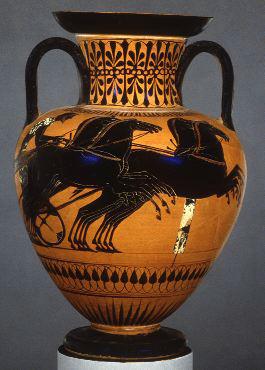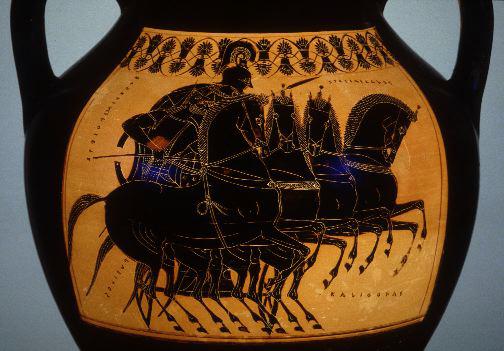





Did politics ever affect the ancient Games?
Politics were present at the ancient Olympics in many forms. In 365 B.C., the Arcadians and the Pisatans took over the Altis, and they presided over the 104th Olympiad the next year. When the Eleans finally regained control of Olympia, they declared the 104th Games invalid.Some valuable political deeds were recorded at Olympia. An inscription on a victory statue honored Pantarces of Elis not only for winning in the Olympic horse-races, but also for making peace between the Achaeans and the Eleans, and negotiating the release of both sides' prisoners of war.

Side A: scene at center; charioteer crossing finish line
Photograph by Maria Daniels, courtesy of Harvard University Art Museums
| While the Olympic Games were being celebrated, Alexander had it proclaimed in Olympia that all exiles should return to their cities, except those who had been charged with sacrilege or murder. He selected the oldest of his soldiers who were Macedonians and released them from service; there were ten thousand of these. He learned that many of them were in debt, and in a single day he paid their obligations... Diodorus Siculus, Library , 17.109.1-2 |
Olympia was also a place for announcing political alliances. Thucydides describes a 100-year military treaty the Athenians, Argives, Mantineans, and Eleans entered into, which was recorded in public inscriptions on stone pillars at the first three cities, and on a bronze pillar at Olympia.
| The tyrant of Athens, Pisistratus, exiled Cimon, a wealthy aristocrat, blaming him for a military and political disaster. "While in exile [Cimon] happened to take the Olympic prize in the four-horse chariot...At the next Olympic games he won with the same horses, but permitted Pisistratus to be proclaimed victor, and by resigning the victory to him he came back from exile to his own property under truce." Herodotus, Histories , 6.103.2 |

Side A: four-horse chariot
Photograph by Maria Daniels, courtesy of the Toledo Museum of Art
To read more about these topics, see Further Resources.
- The Greek city-states and the religious festival
- Excellence and the competitive spirit
- The Olympic truce
- The ancient athlete: amateur or professional?
- Did politics ever affect the ancient Games?
- Spectators at the Games
- Cultural achievements and the Games
This exhibit is a subset of materials from the Perseus Project database and is copyrighted. Please send us your comments.